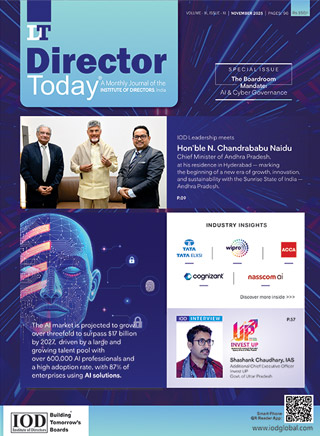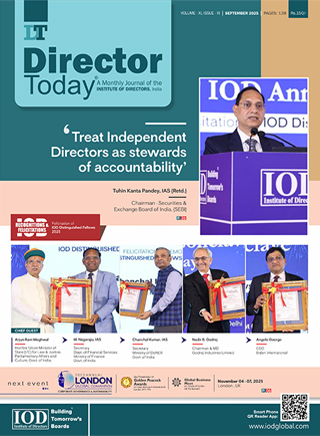AI's Role in ESG Oversight: From Rear-View to Radar

The ESG Imperative meets AI Revolution
Boards today face a paradox. They are overwhelmed with data, yet often under-informed when it comes to making timely, strategic decisions on ESG matters.
Traditional ESG reports are backward-looking, compliance-heavy, and fragmented. Meanwhile, investors, regulators, and stakeholders are demanding accuracy, transparency, and speed.
Mr. Larry Fink of BlackRock once wrote, “Climate risk is investment risk.” In the same way, “ESG risk is now a boardroom risk.” The question is no longer whether Boards should focus on ESG, but how they can strengthen oversight in a landscape where expectations shift by the quarter, not by the decade.
This is where Artificial Intelligence (AI) steps in. From realtime emissions tracking to predictive social-risk analytics and automated sustainability narratives, AI is transforming ESG from a checkbox exercise into a strategic lever.
Why the Old Way No Longer Works
The evolution of ESG tells a clear story.
It began as voluntary CSR reports, largely glossy narratives with limited accountability. Over the years, frameworks such as GRI, SASB, and TCFD brought structure. In India, ESG reporting has matured into SEBI's Business

Responsibility and Sustainability Report (BRSR), making ESG disclosures mandatory for the top 1,000 listed entities.
Yet, the challenge persists. ESG data comes from scattered sources: Internet of Things sensors measuring emissions, HR systems tracking diversity, whistleblower logs on governance, and even satellite images monitoring land use. Without standardisation, this data is siloed and inconsistent. For Boards, that means poor visibility and reactive oversight.
The result?
Reports that satisfy regulators but often fail to equip directors for meaningful decisions.
The Rise of Artificial Intelligence
• Aggregating data from multiple sources - cloud systems, IoT sensors, filings, even social media.
• Detecting patterns - Machine Learning (ML) can forecast ESG risks like supply-chain disruptions or reputational fallout.
• Automating reporting - Natural Language Generation (NLG) tools can draft BRSR or GRI-aligned reports at scale.
• Providing real-time dashboards - Boards no longer need to wait for annual disclosures; they can see ESG metrics live, alongside financial KPIs.
In essence, AI enables Boards to shift from compliance oversight to strategic foresight.
Case Studies: Lessons from Global and Indian Leaders
Microsoft: Cloud for Sustainability
Microsoft has built a platform that unifies ESG data across systems. Using AI, it tracks Scope 1–3 emissions, integrates IoT data, and delivers audit-ready, ISSB-aligned reports. Its dashboards allow executives and Boards to simulate climate scenarios while answering not just “where are we today?” but “what will happen if we stay on this path?”
Closer to home, Infosys has created an in-house AIpowered ESG tools. These automate materiality assessments, track 100+ indicators, and even generate first drafts of sustainability reports. By doing so, Infosys reduces the burden of manual reporting and enables its Board to focus on strategy, not spreadsheets.
Tata Steel: AI in Heavy Industry
Tata Steel integrates AI with IoT and satellite data to monitor emissions and biodiversity. Its dashboards, used at the Board subcommittee level, provide predictive alerts for potential environmental incidents. In a sector often criticised for emissions, this proactive approach builds resilience and credibility.
These examples show how AI is not just a tech add-on but a governance enabler.
Strategic Implications for Boards
1. Upskilling and Digital Fluency
Boards cannot delegate AI understanding entirely to management. Directors must learn to interpret AIdriven ESG dashboards, question algorithms, and understand biases. Just as financial literacy became a baseline for directors, AI-ESG literacy is becoming nonnegotiable.
2. Oversight of Responsible AI
ESG Committees, like Audit Committees, must now extend their role to oversee AI usage. Questions of explainability, ethical AI, and transparency should be a part of every ESG oversight discussion.
Just as financial literacy became a baseline for directors, AI-ESG literacy is becoming non-negotiable.
3. Integration into Enterprise Risk Management
AI-enabled ESG insights should flow directly into Enterprise Risk Management (ERM) frameworks. This allows Boards to use ESG data in capital allocation, M&A decisions, and crisis preparedness rather than treating it as an afterthought.
4. Stakeholder Engagement
AI chatbots and dashboards are already being used to communicate ESG progress to investors and communities in real time. Boards must ensure these tools are accurate and trustworthy, because stakeholder trust is easily lost.
The Challenges to Watch
While the promise is clear, Boards must remain alert to certain risks:
• Data quality: “Garbage in, garbage out” applies to ESG more than anywhere else.
• Bias in algorithms: If AI models reflect flawed assumptions, they can create misleading ESG scores or materiality maps.
• Affordability: Large firms can invest in AI platforms, but mid-sized companies may struggle. This raises questions about equitable adoption.
• Regulatory fragmentation: With ISSB, EU's CSRD, SEBI's BRSR, and other frameworks, global alignment remains a moving target even with AI.
Generative AI: The Next Wave
Generative AI (GenAI) is already being piloted to:
• Draft ESG reports using both public and internal data.
• Benchmark companies against peers for Board discussions.
• Create investor-ready ESG narratives.
• Power chatbots that answer stakeholder questions in plain language.
But GenAI raises questions of accuracy and governance. Boards must insist on strong guardrails ensuring that AI AIgenerated narratives remain fact-based, transparent, and aligned with regulatory expectations.
Call to Action: From Data to Decisions
The message is clear: ESG cannot remain a backwardlooking compliance burden. With AI, Boards have the tools to make ESG reporting real-time, decision-relevant, and value-creating.
For directors, the call to action is three-fold:
1. Invest in AI-ESG literacy - Make it a part of director education and on-boarding.
2. Mandate ESG dashboards - Require management to provide live AI-enabled metrics, not just annual reports.
3. Champion Responsible AI - Set standards for ethics, transparency, and accountability in AI-driven ESG tools.
As Peter Drucker famously said, “What gets measured, gets managed.” In the ESG era, one might add: “What gets managed with intelligence, gets transformed.”
Conclusion
Artificial Intelligence is not a silver bullet, but it is a powerful enabler. It offers Boards the chance to move ESG from being a compliance cost to becoming a strategic advantage.
The path forward requires more than technology. It demands digitally fluent Boards, responsible AI governance, and integration of ESG insights into every critical decision. The Boards that embrace this shift will not just comply with regulations they will build resilient, future-ready enterprises trusted by investors, employees, and society at large.
Author

Mr. Santanu Sengupta
He is a seasoned global banking leader with three decades of experience spearheading business growth, governance, risk management, and transformation across leading international banks. As former MD & APAC South Head at Wells Fargo, Singapore, he led businesses across 15 countries and now shapes strategy at a leading cyber risk management firm.
Owned by: Institute of Directors, India
Disclaimer: The opinions expressed in the articles/ stories are the personal opinions of the author. IOD/ Editor is not responsible for the accuracy, completeness, suitability, or validity of any information in those articles. The information, facts or opinions expressed in the articles/ speeches do not reflect the views of IOD/ Editor and IOD/ Editor does not assume any responsibility or liability for the same.

 Quick Links
Quick Links
 Connect us
Connect us




 Back to Home
Back to Home






























